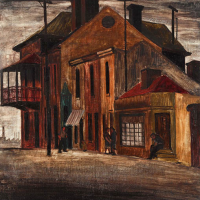20. JEFFREY SMART Hindley Street at Evening 1943-44

Jeffrey Smart is known for his carefully drawn and constructed urban landscapes. He combines flat areas of colour against a carefully balanced geometry derived from the straight lines and antiseptic spaces of the contemporary city landscape and its arid hinterlands. Blousy, slightly faded industrial artefacts are depicted with bright inflections of colour, often with isolated figures offsetting the municipal landscape. With their advertising, buses, road signs and the post-Bauhaus buildings that dominated the post-war years, the look of a Jeffrey Smart painting is resolutely international. In contrast, this early work, Hindley Street at Evening 1943-44, with its warm earth colours reminiscent of the parched landscapes of Russell Drysdale, is very Australian.
Smart was born, grew up and attended art school in what was a very provincial Adelaide. Conservative artist Ivor Hele (1912-1993) gave him a grounding in traditional techniques and Dorrit Black (1891-1951) passed on the essentials of modernity. Knowing he was far from the centre and aware he didnt quite belong, he yearned for the brilliance of the bigger world. He savoured contemporary culture by reading books, listening to concerts and immersing himself in poetry. TS Eliot (1888-1965) was a particular hero and The Preludes was a favourite piece and a source of inspiration:
The winter evening settles down
With smell of steaks in passageways.
Six oclock.
The burnt-out ends of smoky days.
And now a gusty shower wraps
The grimy scraps
Of withered leaves about your feet
And newspapers from vacant lots;
The showers beat
On broken blinds and chimney-pots,
It was not long Smart later wrote, before I had painted several vacant lots.. On my first acquaintance with Elliots poems they provided me with images of urban life which were valid. I had painted my last flower piece; the gum trees and the billabongs and blue hills had been thrown out with the daffodils.1
Hindley Street at Evening was part of Smarts desire to depict the gritty essence of contemporary city life. His family had moved from the suburbs to live in a flat on South Terrace and Smart was captivated by the inner-city neighbourhood: I always liked the look of that confusion of chimneys and temporary erections and things going across and pipes and telegraph poles and all that nest of things going on there, it fascinated me and I did drawings of them of course.2 Equipped with a paint box and easel, Smart would choose an appropriate local setting and paint on site as he likely did with this work. Hindley Street was known for its hotels, pubs, theatres, bookshops and coffeehouses providing an attractive and suitably seedy bohemian locale for a young artist.
The verticals of telephone poles, chimneys, gas pipes and the diagonal roofs and vanishing points show Smarts absorption of Dorrit Blacks advice to compose a work and the chorus of ochres, umbers and siennas demonstrates the palette of earth colours endorsed by his teachers, notably Ivor Hele, but also by the exemplars of the new Australian art like Russell Drysdale (1912-1981) whose work was already receiving acclaim. A silhouette of sawtooth factories in the distant background (a recurring motif in his work) suggests the locale as the point where Hindley meets West Terrace, foregrounding the stock and railyards and light industry beyond. The image of a decaying street, all sombre browns and dulled reds beneath a grey sky, provides a suitable backdrop for the human drama choreographed by Smart. An embracing couple occupies the centre, a figure on the left looks on with intense concentration, perhaps even anger, while the figure on the right appears defeated, overwhelmed with despair. Smart aims to prick the social conscience with a mise-en-scne seemingly visualising the realism of Scandinavian playwright Hendrik Ibsen (1828-1906), but achieves a wistful Australian Gothic replete with enchanting shadows and a sweet melancholy of dilapidated buildings. He was soon to realise greater power in his work by employing a less proscriptive narrative and fewer figures, often just a single person in an ambiguous, passive pose. Drama became invested in the precariously balanced architecture of his compositions, with the figure as genius loci, the point of an unrealised drama, as potent as Chekhovs gun.3
Like Chekhovs gun, Hindley Street at Evening anticipates future action. The pieces are all laid out in this charming and prescient early work to be developed in the mature paintings of the next decade. Against a backdrop of naturalism championed by Adelaides local heroes Hans Heysen (1877-1968) and Horace Trenerry (1899-1958) as well as the general legacy of the Heidelberg school, Smarts Hindley Street at Evening marks a radical change in ambition, not just for the artist himself, but for Australian art. Hindley Street at Evening is a vital key to understanding the trajectory of this outstanding contemporary painter.
Footnotes
1. Smart, J., Not Quite Straight, Heinemann, Melbourne, 1996, p.36
2. Smart interviewed by film director Catherine Hunter in Jeffrey Smart - Master of Stillness, Catherine Hunter Productions Pty Ltd, Sydney, 2012
3. A principle in theatre and film that was first articulated by Russian playwright Anton Chekhov that If you say in the first chapter that there is a rifle hanging on the wall, in the second or third chapter it absolutely must go off.
Michael Desmond